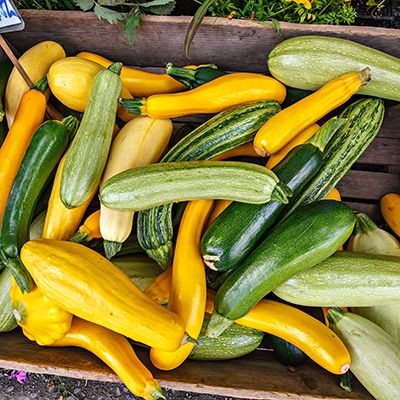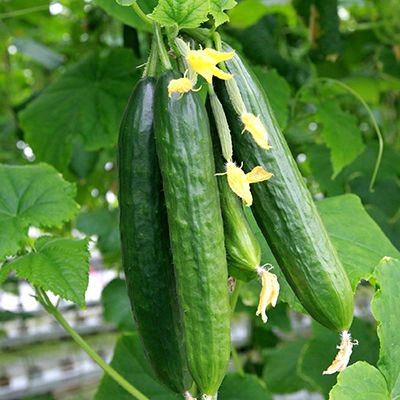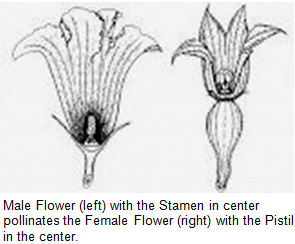


Squash, Cucumber, Pumpkin, etc.
All these members of the squash family need a loose, well-draining soil. If you have been amending your soil for the past 8 to 10 years or are planting in raised beds your soil is probably suitable. Otherwise, prepare at least a four square foot area for each of the plants by following directions outlined on the Soils Care Guide.
All of these plants have a tropical or semi-tropical origin and require full sun for best growth.
SQUASH fall into two groups: Summer Squash (Patty Pan, Crookneck and Zucchini), which are harvested and eaten when immature and Winter Squash (Turban, Acorn, Banana, etc.), which are harvested in late summer or fall with a hard rind. Both groups have vining and a few bush types. Generally, Winter Squash grows on vines and needs more space than Summer Squash. Bush varieties are best planted in hills of 2 or 3 plants, allowing 4 to 5 feet of space. Vining types need at least 8 feet of space. Fertilize monthly with Master Nursery Tomato and Vegetable Food, and water enough to keep the soil and roots moist. Avoid watering the leaves and stems to prevent leaf and fruit diseases.
PUMPKINS require the same treatment as Winter Squash. Most types are vining, but a few bush types are available. Vining types may occupy up to 500 square feet and bush types up to 20 square feet. The fruits normally range in size from 2 to 3 inches in diameter up to 20 inches in diameter. Giant Pumpkins aren’t special varieties; they are ordinary, full-sized Pumpkins, grown in a special way (e.g. Atlantic Giant or Big Max).
CUCUMBERS may also be the vining or bush type. A vine needs up to 25 square feet of space for normal growth, but a more efficient use of space can be made by growing the vines on a trellis or tomato cage. When the vines trail on the ground, the fruits may grow bent and misshapen. When trained to a trellis or tomato cage, the fruits hang and grow in a straight uniform manner. Cucumbers are available in a multitude of varieties: Slicing Cucumbers, Pickling, Lemon, Burp Less and Long Slim Asian Cucumbers. Armenian Cucumbers are actually melons with a mild Cucumber flavor. Cucumbers require the same growth conditions as Winter Squash except for the trellis support. It is absolutely imperative that Cucumber plants not be allowed to dry out even a little bit, which will cause the fruit to become bitter or misshapen.
All of the Cucurbits can be planted from seeds or starts. If planting from seeds about the middle to the end of March and from starts when available. The young plants may be attacked by snails, slugs or birds. For snails and slugs, use DEADLINE unless there are pets and children on the property; then use Sluggo. Use white row covers or bird netting to keep birds off the plants until they are 9 to 12 inches tall.
All of the Cucurbits are pollinated by bumble bees rather than honey bees so anything you can do to encourage them will benefit your Squash, Cucumbers and Pumpkins. Be sure to remove row covers when flowers appear on your plants so that the bees can reach them.
Occasionally, gardeners will have Squash that grow to 2 or 3 inches long and then fall off the vine. This happens when the female flower is not pollinated (see sketch below). A similar situation may occur with Cucumbers and in some cases not even the immature fruit appears. All of the Cucurbits have both male and female flowers on the same plant. Under ideal conditions, the bumble bees pick up pollen from the male flowers and transfer it to the female flowers causing the fruit to develop. If the female flowers develop before the male flowers or if there are no bumble bees, then no pollination occurs and no mature fruit develops. Often, within a few weeks, Mother Nature gets things in balance and fruit develops normally. In rare cases, the gardener must play the role of the bumble bee. The gardener reaches into the male flower (see sketch below) and removes the pollen coated stamen and uses it to transfer pollen onto the female pistil. Pollination has been completed and fruits will develop normally. One stamen can be used to pollinate several of the female flowers. If there is difficulty distinguishing the male and female flowers, the female flower has a prominent bulge below the cup-shaped flower (below).

If your plants become infested with Cucumber beetles or other chewing insects, spray the plant with Spinosad which can be used up to one day before harvest. Malathion can also be used and will control both chewing and sucking insects for 5 days before harvest.